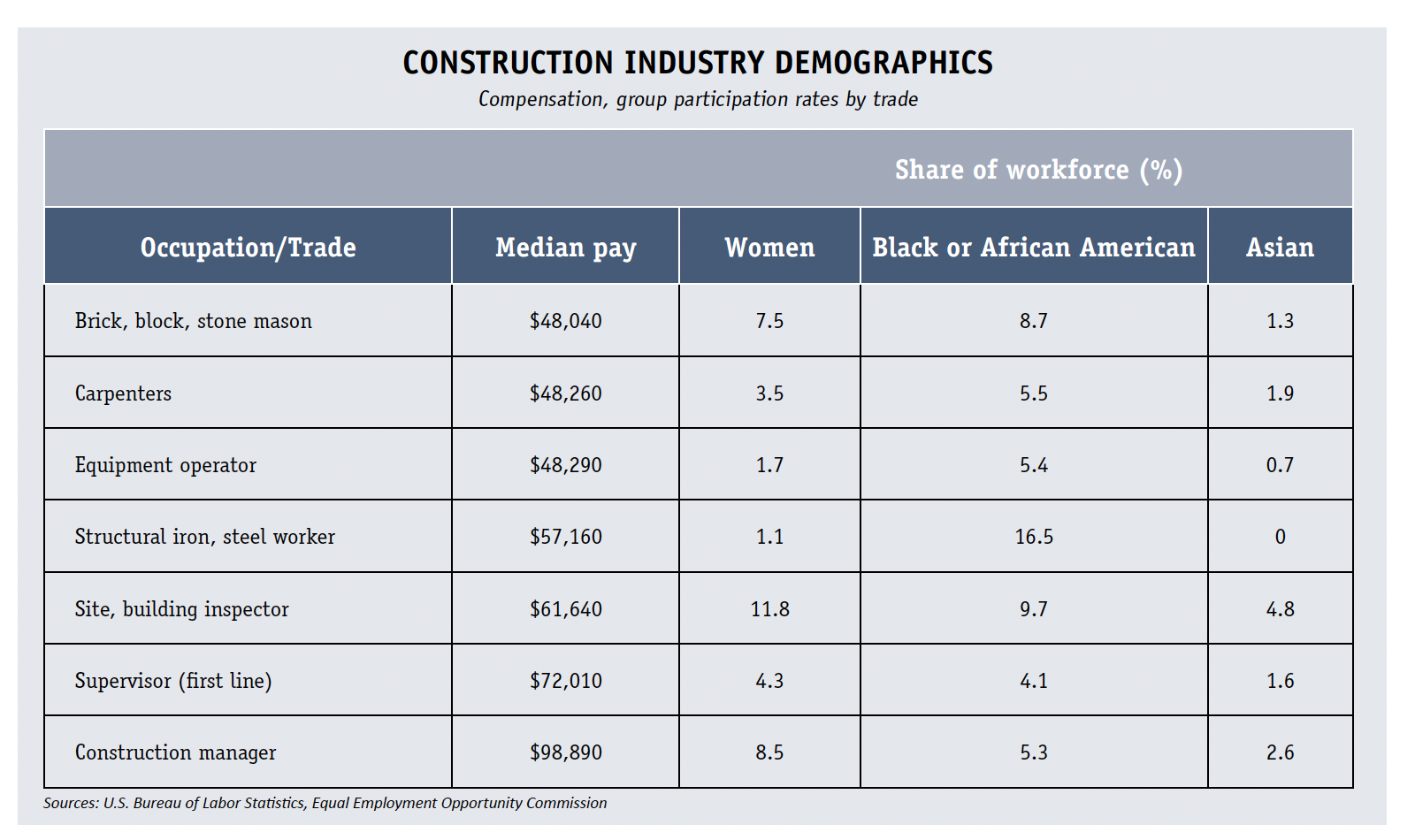A new report deep on demographic and compensation data across construction trades will inform the U.S. Equal Employment Opportunity Commission’s next steps to address discrimination and harassment. “Building For The Future: Advancing Equal Employment Opportunity in the Construction Industry” includes a brief business overview, followed by a discussion of employment discrimination based on race, national origin, and sex in the industry through the lens of the Commission’s publicly resolved cases over the past decade. Authors contend:
- Women and people of color are underrepresented in the construction industry and especially in the higher-paid, higher-skilled trades;
- Discrimination based on sex, race, and national origin persists and contributes to the underrepresentation of women and workers of color in construction;
- Harassment is pervasive on many worksites and poses a significant barrier to the recruitment and retention of women and workers of color in the industry;
- Racial harassment in construction often takes virulent forms on jobsites across the country;
- Harassment in construction is a workplace safety and civil rights issue;
- Construction workers who experience discrimination often do not know to whom or how to report violations; and,
- Retaliation is a serious problem in construction and hinders efforts to prevent and remedy unlawful discrimination and harassment.
“The recent historic federal infrastructure investments provide a once-in-a-generation opportunity to break down barriers in the construction industry,” says EEOC Chair Charlotte Burrows. “While discrimination has long been an issue in the industry, we can decide the future. I look forward to working with industry leaders to help ensure safe and inclusive workplaces for all.” The report outlines forthcoming agency measures, she adds, among them:
- Developing industry-specific technical assistance for employers, unions, and workers to perpetuate fair hiring practices, equal treatment on the job, plus safe and inclusive workplaces;
- Meeting with employers, industry groups, workers, and unions to understand their needs, develop coalitions, and provide information about their rights and duties under federal laws prohibiting employment discrimination;
- Partnering with employers, unions and community-based organizations to provide effective anti-harassment training to apprentices and workers; and,
- Working cooperatively with other federal, state, and local anti-discrimination agencies to advance equal employment opportunity in the industry.

BUILDING INSTITUTE GAUGES DEI METRICS
The National Institute of Building Sciences’ 2023 Built Environment Workforce Survey, prepared in partnership with Chicago-based Avenue M Group, takes the pulse on where things stand regarding diversity, equity, and inclusion. More than seven in 10 survey respondents included race, ethnicity, gender, and age in their definition of diversity within the context of the built environment. Nearly two-thirds of respondents said it’s important to increase diversity of the built environment. Overall, younger respondents—aged 39 or younger and 40 to 49—as well as women were more likely to indicate the importance with regard to increasing diversity.
More than two-thirds of respondents were men, and about three in 10 were women. More than four in five identified as white and/or a person of European descent. Seven percent of respondents identified as Hispanic and/or Latina or Latino; 4 percent identified as Black, African American, and/or a person of African descent; 4 percent identified as East Asian; and, 3 percent identified as Native American. Sixty-seven percent of respondents work in private industry or business, the majority employed full-time, and about half reporting built environment tenure of 20-plus years.
Organizations participating in the survey, all seeking to obtain consistent data across many industry sectors, include the Concrete Advancement Foundation (former RMC Research and Education Foundation), American Institute of Architects, American Institute of Steel Construction, American Society of Civil Engineers, American Society of Landscape Architects, ASTM International, International Code Council, and U.S. Green Building Council.
“Nearly 30 partner organizations participated in this massive effort to look at diversity, inclusion, and social equity in our industry,” says NIBS President A.C. Powell. “This report offers insight on leveling this playing field to open up opportunities for all.”